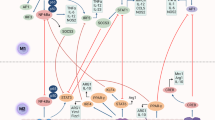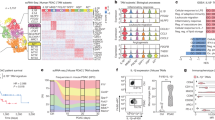Abstract
An elevated level of macrophage inhibitory cytokine-1 (MIC-1) is reported in the sera of patients with metastatic prostate cancer compared with that of benign diseases and healthy adults. We investigated the mechanistic role of MIC-1 overexpression in the metastasis of prostate cancer cells. Our study showed a progressive increase in secretory MIC-1 production correlated with the increase in the metastatic potential of PC-3 and LNPCa prostate cancer metastatic variants. Further, the in vitro studies using ‘loss-’ and ‘gain’-of-function approaches showed that ectopic overexpression of MIC-1 (PC-3-MIC-1) and forced downregulation of MIC-1(PC-3M-siMIC-1) enhanced and reduced the motility and invasiveness of these cells, respectively. Supporting our in vitro observations, all the mice orthotopically implanted with PC-3-MIC-1 cells developed metastasis compared with none in the PC-3-vector group. Our results showed that MIC-1 overexpression was associated with apparent changes in actin organization. In addition, an enhanced phosphorylation of focal adhesion kinase (FAK) and guanosine-5′-triphosphate (GTP)-bound RhoA was also seen; however, no significant change was observed in total FAK and RhoA levels in the PC-3-MIC-1 cells. Altogether, our findings show that MIC-1 has a role in prostate cancer metastasis, in part, by promoting the motility of these cells. Activation of the FAK–RhoA signaling pathway is involved in MIC-1-mediated actin reorganization, and thus, leads to an increase in the motility of prostate cancer cells.
This is a preview of subscription content, access via your institution
Access options
Subscribe to this journal
Receive 50 print issues and online access
$259.00 per year
only $5.18 per issue
Buy this article
- Purchase on Springer Link
- Instant access to full article PDF
Prices may be subject to local taxes which are calculated during checkout





Similar content being viewed by others
References
Baek SJ, Kim KS, Nixon JB, Wilson LC, Eling TE . (2001). Cyclooxygenase inhibitors regulate the expression of a TGF-beta superfamily member that has proapoptotic and antitumorigenic activities. Mol Pharmacol 59: 901–908.
Banyard J, Zetter BR . (1998). The role of cell motility in prostate cancer. Cancer Metastasis Rev 17: 449–458.
Barrack ER . (1997). TGF beta in prostate cancer: a growth inhibitor that can enhance tumorigenicity. Prostate 31: 61–70.
Bauskin AR, Brown DA, Junankar S, Rasiah KK, Eggleton S, Hunter M et al. (2005). The propeptide mediates formation of stromal stores of PROMIC-1: role in determining prostate cancer outcome. Cancer Res 65: 2330–2336.
Bootcov MR, Bauskin AR, Valenzuela SM, Moore AG, Bansal M, He XY et al. (1997). MIC-1, a novel macrophage inhibitory cytokine, is a divergent member of the TGF-beta superfamily. Proc Natl Acad Sci USA 94: 11514–11519.
Bottner M, Suter-Crazzolara C, Schober A, Unsicker K . (1999). Expression of a novel member of the TGF-beta superfamily, growth/differentiation factor-15/macrophage-inhibiting cytokine-1 (GDF-15/MIC-1) in adult rat tissues. Cell Tissue Res 297: 103–110.
Chen SJ, Karan D, Johansson SL, Lin FF, Zeckser J, Singh AP et al. (2007). Prostate-derived factor as a paracrine and autocrine factor for the proliferation of androgen receptor-positive human prostate cancer cells. Prostate 67: 557–571.
Chikumi H, Fukuhara S, Gutkind JS . (2002). Regulation of G protein-linked guanine nucleotide exchange factors for Rho, PDZ-RhoGEF, and LARG by tyrosine phosphorylation: evidence of a role for focal adhesion kinase. J Biol Chem 277: 12463–12473.
D'Amico AV, Whittington R, Malkowicz SB, Schultz D, Blank K, Broderick GA et al. (1998). Biochemical outcome after radical prostatectomy, external beam radiation therapy, or interstitial radiation therapy for clinically localized prostate cancer. JAMA 280: 969–974.
Fairlie WD, Moore AG, Bauskin AR, Russell PK, Zhang HP, Breit SN . (1999). MIC-1 is a novel TGF-beta superfamily cytokine associated with macrophage activation. J Leukoc Biol 65: 2–5.
Hodge JC, Bub J, Kaul S, Kajdacsy-Balla A, Lindholm PF . (2003). Requirement of RhoA activity for increased nuclear factor kappaB activity and PC-3 human prostate cancer cell invasion. Cancer Res 63: 1359–1364.
Hromas R, Hufford M, Sutton J, Xu D, Li Y, Lu L . (1997). PLAB, a novel placental bone morphogenetic protein. Biochim Biophys Acta 1354: 40–44.
Jemal A, Siegel R, Ward E, Hao Y, Xu J, Murray T et al. (2008). Cancer statistics, 2008. CA Cancer J Clin 58: 71–96.
Johnen H, Lin S, Kuffner T, Brown DA, Tsai VW, Bauskin AR et al. (2007). Tumor-induced anorexia and weight loss are mediated by the TGF-beta superfamily cytokine MIC-1. Nat Med 13: 1333–1340.
Karan D, Chen SJ, Johansson SL, Singh AP, Paralkar VM, Lin MF et al. (2003). Dysregulated expression of MIC-1/PDF in human prostate tumor cells. Biochem Biophys Res Commun 305: 598–604.
Karan D, Holzbeierlein J, Thrasher JB . (2009). Macrophage inhibitory cytokine-1: possible bridge molecule of inflammation and prostate cancer. Cancer Res 69: 2–5.
Karan D, Kelly DL, Rizzino A, Lin MF, Batra SK . (2002). Expression profile of differentially-regulated genes during progression of androgen-independent growth in human prostate cancer cells. Carcinogenesis 23: 967–975.
Kozlowski JM, Fidler IJ, Campbell D, Xu ZL, Kaighn ME, Hart IR . (1984). Metastatic behavior of human tumor cell lines grown in the nude mouse. Cancer Res 44: 3522–3529.
Lambert JR, Kelly JA, Shim M, Huffer WE, Nordeen SK, Baek SJ et al. (2006). Prostate derived factor in human prostate cancer cells: gene induction by vitamin D via a p53-dependent mechanism and inhibition of prostate cancer cell growth. J Cell Physiol 208: 566–574.
Lawton LN, Bonaldo MF, Jelenc PC, Qiu L, Baumes SA, Marcelino RA et al. (1997). Identification of a novel member of the TGF-beta superfamily highly expressed in human placenta. Gene 203: 17–26.
Lee DH, Yang Y, Lee SJ, Kim KY, Koo TH, Shin SM et al. (2003). Macrophage inhibitory cytokine-1 induces the invasiveness of gastric cancer cells by up-regulating the urokinase-type plasminogen activator system. Cancer Res 63: 4648–4655.
Liu T, Bauskin AR, Zaunders J, Brown DA, Pankhurst S, Russell PJ et al. (2003). Macrophage inhibitory cytokine 1 reduces cell adhesion and induces apoptosis in prostate cancer cells. Cancer Res 63: 5034–5040.
McLean GW, Carragher NO, Avizienyte E, Evans J, Brunton VG, Frame MC . (2005). The role of focal-adhesion kinase in cancer—a new therapeutic opportunity. Nat Rev Cancer 5: 505–515.
Padua D, Massague J . (2009). Roles of TGFbeta in metastasis. Cell Res 19: 89–102.
Paralkar VM, Vail AL, Grasser WA, Brown TA, Xu H, Vukicevic S et al. (1998). Cloning and characterization of a novel member of the transforming growth factor-beta/bone morphogenetic protein family. J Biol Chem 273: 13760–13767.
Patrikainen L, Porvari K, Kurkela R, Hirvikoski P, Soini Y, Vihko P . (2007). Expression profiling of PC-3 cell line variants and comparison of MIC-1 transcript levels in benign and malignant prostate. Eur J Clin Invest 37: 126–133.
Pettaway CA, Pathak S, Greene G, Ramirez E, Wilson MR, Killion JJ et al. (1996). Selection of highly metastatic variants of different human prostatic carcinomas using orthotopic implantation in nude mice. Clin Cancer Res 2: 1627–1636.
Robinson VL, Kauffman EC, Sokoloff MH, Rinker-Schaeffer CW . (2004). The basic biology of metastasis. Cancer Treat Res 118: 1–21.
Schlaepfer DD, Mitra SK, Ilic D . (2004). Control of motile and invasive cell phenotypes by focal adhesion kinase. Biochim Biophys Acta 1692: 77–102.
Selander KS, Brown DA, Sequeiros GB, Hunter M, Desmond R, Parpala T et al. (2007). Serum macrophage inhibitory cytokine-1 concentrations correlate with the presence of prostate cancer bone metastases. Cancer Epidemiol Biomarkers Prev 16: 532–537.
Sieg DJ, Hauck CR, Ilic D, Klingbeil CK, Schaefer E, Damsky CH et al. (2000). FAK integrates growth-factor and integrin signals to promote cell migration. Nat Cell Biol 2: 249–256.
Sporn MB . (1996). The war on cancer. Lancet 347: 1377–1381.
Wakchoure S, Swain TM, Hentunen TA, Bauskin AR, Brown DA, Breit SN et al. (2009). Expression of macrophage inhibitory cytokine-1 in prostate cancer bone metastases induces osteoclast activation and weight loss. Prostate 69: 652–661.
Welsh JB, Sapinoso LM, Kern SG, Brown DA, Liu T, Bauskin AR et al. (2003). Large-scale delineation of secreted protein biomarkers overexpressed in cancer tissue and serum. Proc Natl Acad Sci USA 100: 3410–3415.
Zhai J, Lin H, Nie Z, Wu J, Canete-Soler R, Schlaepfer WW et al. (2003). Direct interaction of focal adhesion kinase with p190RhoGEF. J Biol Chem 278: 24865–24873.
Acknowledgements
This study was supported, in part, by grants from the Department of Defense (PC040502 and PC074289). We thank Dr Ajay P Singh for reading the paper and for his valuable suggestions. We also thank Erik Moore for his technical assistance and Kristi LW Berger for editing the paper. We also acknowledge the NCI Cancer Center Support Grant (P30 CA36727) to UNMC.
Author information
Authors and Affiliations
Corresponding author
Additional information
Supplementary Information accompanies the paper on the Oncogene website (http://www.nature.com/onc)
Rights and permissions
About this article
Cite this article
Senapati, S., Rachagani, S., Chaudhary, K. et al. Overexpression of macrophage inhibitory cytokine-1 induces metastasis of human prostate cancer cells through the FAK–RhoA signaling pathway. Oncogene 29, 1293–1302 (2010). https://doi.org/10.1038/onc.2009.420
Received:
Revised:
Accepted:
Published:
Issue Date:
DOI: https://doi.org/10.1038/onc.2009.420
Keywords
This article is cited by
-
Clinical usefulness and acceleratory effect of macrophage inhibitory cytokine-1 on biliary tract cancer: an experimental biomarker analysis
Cancer Cell International (2022)
-
N-glycosylation of GDF15 abolishes its inhibitory effect on EGFR in AR inhibitor-resistant prostate cancer cells
Cell Death & Disease (2022)
-
GDF15 promotes prostate cancer bone metastasis and colonization through osteoblastic CCL2 and RANKL activation
Bone Research (2022)
-
NR5A2 transcriptional activation by BRD4 promotes pancreatic cancer progression by upregulating GDF15
Cell Death Discovery (2021)
-
Growth differentiation factor 15 (GDF15) in cancer cell metastasis: from the cells to the patients
Clinical & Experimental Metastasis (2020)



